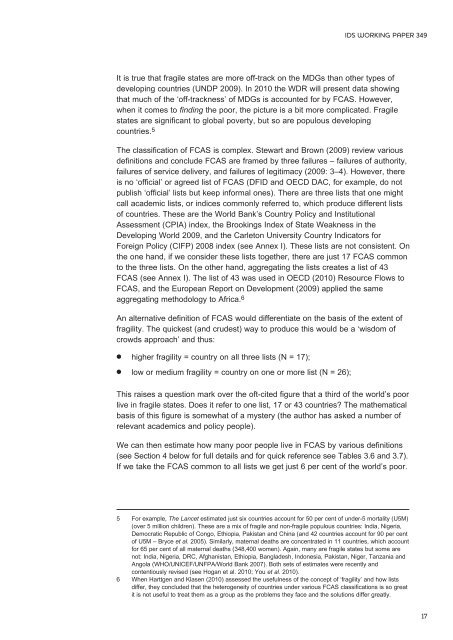Andy Sumner - Institute of Development Studies
Andy Sumner - Institute of Development Studies
Andy Sumner - Institute of Development Studies
Create successful ePaper yourself
Turn your PDF publications into a flip-book with our unique Google optimized e-Paper software.
IDS WORKING PAPER 349It is true that fragile states are more <strong>of</strong>f-track on the MDGs than other types <strong>of</strong>developing countries (UNDP 2009). In 2010 the WDR will present data showingthat much <strong>of</strong> the ‘<strong>of</strong>f-trackness’ <strong>of</strong> MDGs is accounted for by FCAS. However,when it comes to finding the poor, the picture is a bit more complicated. Fragilestates are significant to global poverty, but so are populous developingcountries. 5The classification <strong>of</strong> FCAS is complex. Stewart and Brown (2009) review variousdefinitions and conclude FCAS are framed by three failures – failures <strong>of</strong> authority,failures <strong>of</strong> service delivery, and failures <strong>of</strong> legitimacy (2009: 3–4). However, thereis no ‘<strong>of</strong>ficial’ or agreed list <strong>of</strong> FCAS (DFID and OECD DAC, for example, do notpublish ‘<strong>of</strong>ficial’ lists but keep informal ones). There are three lists that one mightcall academic lists, or indices commonly referred to, which produce different lists<strong>of</strong> countries. These are the World Bank’s Country Policy and InstitutionalAssessment (CPIA) index, the Brookings Index <strong>of</strong> State Weakness in theDeveloping World 2009, and the Carleton University Country Indicators forForeign Policy (CIFP) 2008 index (see Annex I). These lists are not consistent. Onthe one hand, if we consider these lists together, there are just 17 FCAS commonto the three lists. On the other hand, aggregating the lists creates a list <strong>of</strong> 43FCAS (see Annex I). The list <strong>of</strong> 43 was used in OECD (2010) Resource Flows toFCAS, and the European Report on <strong>Development</strong> (2009) applied the sameaggregating methodology to Africa. 6An alternative definition <strong>of</strong> FCAS would differentiate on the basis <strong>of</strong> the extent <strong>of</strong>fragility. The quickest (and crudest) way to produce this would be a ‘wisdom <strong>of</strong>crowds approach’ and thus:●●higher fragility = country on all three lists (N = 17);low or medium fragility = country on one or more list (N = 26);This raises a question mark over the <strong>of</strong>t-cited figure that a third <strong>of</strong> the world’s poorlive in fragile states. Does it refer to one list, 17 or 43 countries? The mathematicalbasis <strong>of</strong> this figure is somewhat <strong>of</strong> a mystery (the author has asked a number <strong>of</strong>relevant academics and policy people).We can then estimate how many poor people live in FCAS by various definitions(see Section 4 below for full details and for quick reference see Tables 3.6 and 3.7).If we take the FCAS common to all lists we get just 6 per cent <strong>of</strong> the world’s poor.5 For example, The Lancet estimated just six countries account for 50 per cent <strong>of</strong> under-5 mortality (U5M)(over 5 million children). These are a mix <strong>of</strong> fragile and non-fragile populous countries: India, Nigeria,Democratic Republic <strong>of</strong> Congo, Ethiopia, Pakistan and China (and 42 countries account for 90 per cent<strong>of</strong> U5M – Bryce et al. 2005). Similarly, maternal deaths are concentrated in 11 countries, which accountfor 65 per cent <strong>of</strong> all maternal deaths (348,400 women). Again, many are fragile states but some arenot: India, Nigeria, DRC, Afghanistan, Ethiopia, Bangladesh, Indonesia, Pakistan, Niger, Tanzania andAngola (WHO/UNICEF/UNFPA/World Bank 2007). Both sets <strong>of</strong> estimates were recently andcontentiously revised (see Hogan et al. 2010; You et al. 2010).6 When Harttgen and Klasen (2010) assessed the usefulness <strong>of</strong> the concept <strong>of</strong> ‘fragility’ and how listsdiffer, they concluded that the heterogeneity <strong>of</strong> countries under various FCAS classifications is so greatit is not useful to treat them as a group as the problems they face and the solutions differ greatly.17
















